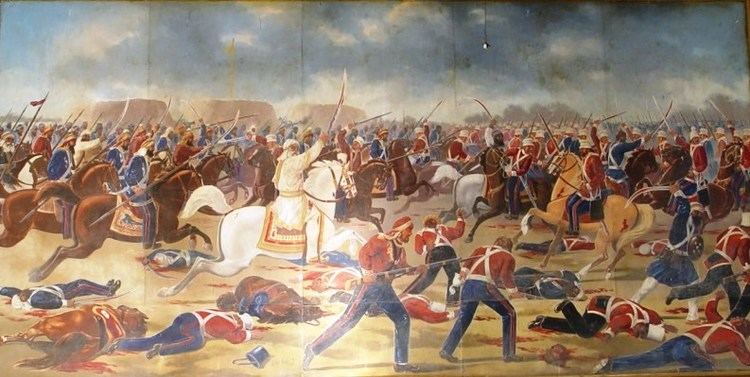Active 1805–1849 | ||
 | ||
Size at its greatest height, during 1838-39, before the death of Maharaja Ranjit Singh of Punjab60,000 men (45,000 Infantry, 10,000 Cavalry and 5,000 artillery) Nickname(s) Fauj-i -Qawaidan (The army with rules) | ||
The Fauj-i-Ain (Punjabi:ਫੌਜ -ਏ-ਐਨ ,Persian:فوج ی این) was a branch of the Sikh Khalsa Army and was the regular army of Maharaja Ranjit Singh of Punjab. It contained infantry, cavalry and artillery units.
Contents
Background
Before the reign of Maharaja Ranjit Singh the armies in Punjab were consisting purely of cavalry. As Ranjit Singh became the Sardar of Sukerchakia Misl The tried to unify with his conquests most of the Punjab. With clever diplomacy and many battles he gradually unified most of Punjab under him. However the Afghans, The British and the Gurkhas were still a very big threat,while his empire was still in its infancy. Therefore in 1805,he started recruiting regular forces and employing East India Company deserters as officers or soldiers. This didn't went very well as most of these deserters were constantly in touch with the British. The British where alarmed with the rapid conquests of Ranjit Singh and sent many diplomatic missions to help the Phulkian sardars from a possible conquest of their lands and check the growing power of the Sikh Sovereign.
A Muslim regiment under Charles Metcalfe, 1st Baron Metcalfe was sent to Amritsar for talks with the Maharaja.The soldiers went into the temple without taking their shoes off,and some Nihang guards unsheathed their sabres and challenged them. The Muslim soldiers formed line and shot many Musket volleys. It resulted in the death of many Nihangs, while others were wounded. This impressed Ranjit Singh and left a deep impact on him. Realising the power of the British Army,he accepted The Treaty of Amritsar (1809),and started modernizing his army on European principles
Formation
It was the Maharaja Ranjit Singh who started to hire European officers to train and command parts of his army. It started in 1805 and contiuned to grow until 1839.
Infantry
Ranjit Singh was fully aware of the importance of infantry. The task of recruitment in this army had started after 1805, which continued throughout his reign. In the beginning, the number of Sikhs in this army was nominal. The reason being that the Sikhs looked down upon infantry. Therefore, in the beginning, Ranjit Singh recruited some Pathans and Gurkhas in this section of his army. Afterwards, owing to Ranjit Singh's efforts, Sikhs too began to join it. In 1822, he employed General Jean-Baptiste Ventura to train the infantry in western pattern. Under his guidance, the infantry became the most disciplined army of within a few years.
By 1838-1839 the strength of the infantry had risen to 45,000. It was divided into battalions, companies and sections. Each battalion consisted of 800 soldiers. It was put under a Commandant. Each battalion was divided into eight companies. Each company was put under a Subedar. Each company was put under 4 sections. Each section consisted of 25 soldiers. It was put under a Jamadar. The Fauj-i-Khas, was also part of the Fauj-i-Ain. It consisted of the elite soldiers of the Sikh Khalsa Army. It had a separate emblem and harsh training.
Cavalry
The second most important part of the army was cavalry. In order to organize it on western lines, Ranjit Singh appointed General Jean-Francois Allard. Under his command, the cavalry became very strong . In 1838-39, the over all strength of the cavalry was 10,000. The cavalry was divided into regiments. Each regiment consisted of 250 to 600 cavaliers. The regiments were further divided into risalas (corps). Each Risala consisted of 150 to 250 cavaliers. The officers and other non-combatants of cavalry were similar to those of infantry. The pay of the cavalry was, however higher than that of the infantry.
Artillery
Ranjit Singh I was fully aware of the importance of artillery in the modern warfare. Therefore, he paid a special attention to the development of artillery in 1810. In 1812 he employed General Claude Auguste Court and Colonel Alexander Gardner in 1832 and organized Topkhana-i-Khas. Under their able guidance the artillery made matchless progress in a few years.Maharaja Ranjit Singh divided his artillery into four categories:
1.Topkhana-i-Fili:Heavy cannons pulled by elephants
2.Topkhana-i-Shutri consisted of those guns which were pulled by camels.
3.Topkhana-i-Aspi consisted of light guns pulled by horses
4.Topkhana-i-Gavi consisted of medium cannons pulled by ciws
The artillery was divided into batteries or deras. Each battery consisted of 10 guns and 250 gunners. Each battery was under a Commandant. The batteries were further divided into sections. Each section compromised 2 guns and 8 to 10 gunners. Each section was under a Jamadar. The entire artillery was under a General.In 1838-39, the strength of the Sikh artillery was 182 heavy cannons, 20 Howitzers, and 60 light cannons. It had at least 5,000 gunners.
